Rapid and Simultaneous Detection of Petroleum Hydrocarbons and Organic Pesticides in Soil Based on Electronic Nose
Abstract
:1. Introduction
2. Materials and Methods
2.1. Real Soil, Petroleum Products, and Organic Pesticides
2.2. Construction of Sampling Module for Simultaneous Detection of Soil Pollution
2.3. Construction of Recognition Model for Simultaneous Detection of Soil Pollution
- The recognition model can simultaneously detect soil petroleum hydrocarbon pollution and organic pesticide pollution, fully reflecting the soil pollution status, and providing accurate support for soil rapid monitoring and precise remediation;
- Each individual functional module needs to process only a limited amount of data, greatly reducing the energy consumption required for data transmission, computation, and storage across the entire model, while improving detection efficiency;
- Each independent functional module only needs to identify a specific soil, making the detection more targeted and significantly improving the detection accuracy.
3. Results and Discussion
3.1. Soil Condition Detection
3.2. Specific Identification of Petroleum Hydrocarbons and Organic Pesticides
4. Conclusions
Author Contributions
Funding
Institutional Review Board Statement
Informed Consent Statement
Data Availability Statement
Conflicts of Interest
Appendix A
| No. | Sensors | Sensitive Gas | Range (ppm) | Manufactor |
|---|---|---|---|---|
| 1 | TGS2612 | methane, LP, etc. | 500~12,500 | Figaro |
| 2 | TGS2611 | methane, natural gas | 500~10,000 | Figaro |
| 3 | TGS2620 | ethanol, organic solvents | 50~5000 | Figaro |
| 4 | TGS2603 | trimethylamine, methanethiol, etc. | 1~10 | Figaro |
| 5 | TGS2602 | ammonia, hydrogen sulfide, etc. | 1~30 | Figaro |
| 6 | TGS2610 | LP, propane, butane | 500~10,000 | Figaro |
| 7 | TGS2600 | hydrogen, alcohol, etc. | 1~30 | Figaro |
| 8 | GSBT11 | volatile organic gases | 10~2000 | OGAM |
| 9 | MS1100 | toluene, formaldehyde, benzene, etc. | 1~1000 | Ruimeng |
| 10 | MP135 | hydrogen, alcohol, carbon monoxide, etc. | 10~500 | Winsen |
| 11 | MP901 | alcohol, formaldehyde, toluene, etc. | 1~50 | Winsen |
| 12 | MP-9 | carbon monoxide, methane | 300~10,000 | Winsen |
| 13 | MP-3B | alcohol | 0~500 | Winsen |
| 14 | MP-4 | methane, natural gas, methane | 300~10,000 | Winsen |
| 15 | MP-5 | propane | 300~10,000 | Winsen |
| 16 | MP-2 | propane, smoke | 200~10,000 | Winsen |
| 17 | MP503 | alcohol, smoke, isobutane, formaldehyde | 1~1000 | Winsen |
| 18 | MP801 | benzene, toluene, formaldehyde, alcohol | 0.5~1000 | Winsen |
| 19 | MP905 | benzene, toluene, formaldehyde, alcohol | 0.5~1000 | Winsen |
| 20 | MP402 | methane, natural gas | 300~10,000 | Winsen |
| 21 | WSP1110 | nitrogen dioxide | 0.1~10 | Winsen |
| 22 | WSP2110 | toluene, formaldehyde, benzene, etc. | 1~50 | Winsen |
| 23 | WSP7110 | hydrogen sulfide | 0~50 | Winsen |
| 24 | MP-7 | carbon monoxide | 50~1000 | Winsen |
| 25 | MP-702 | ammonia | 0~100 | Winsen |
| 26 | TGS2618 | butane, LP gas | 500~10,000 | Figaro |
| Classifier | Parameter | Scope |
|---|---|---|
| SVM | Penalty coefficient (C) | 0.1~100 |
| Coefficient of kernel function (gamma) | ||
| Kernel function | RBF, linear, polynomial | |
| RF | Decision tree | 100~500 |
References
- McGinley, J.; O’Driscoll, J.H.; Healy, M.G.; Ryan, P.C.; Mellander, P.E.; Morrison, L.; Callery, O.; Siggins, A. An assessment of potential pesticide transmission, considering the combined impact of soil texture and pesticide properties: A meta-analysis. Soil Use Manag. 2022, 38, 1162–1171. [Google Scholar] [CrossRef] [PubMed]
- Kolesnikov, S.I.; Kazeev, K.S.; Tatosyan, M.L. The effect of pollution with oil and oil products on the biological status of ordinary chernozems. Eurasian Soil Sci. 2006, 39, 552–556. [Google Scholar] [CrossRef]
- Gunstone, T.; Cornelisse, T.; Klein, K.; Dubey, A.; Donley, N. Pesticides and soil invertebrates: A hazard assessment. Front. Environ. Sci. 2021, 9, 643847. [Google Scholar] [CrossRef]
- Larson, J. Pesticides in Surface Waters: Distribution, Trends and Governing Factors; CRC Press: Boca Raton, FL, USA, 1997. [Google Scholar]
- Mac, M.; Peluso, L.; Marino, G. Evaluation of pesticide pollution in the Gualeguay Basin: An extensive agriculture area in Argentina. Sci. Total Environ. 2022, 851, 158142. [Google Scholar]
- El-Nahhal, I.; El-Nahhal, Y. Pesticide residues in drinking water, their potential risk to human health and removal options. J. Environ. Manag. 2021, 299, 113611. [Google Scholar] [CrossRef]
- Blair, A.; Ritz, B.; Wesseling, C.; Freeman, L.B. Pesticides and human health. Occup. Environ. Med. 2015, 72, 81–82. [Google Scholar] [CrossRef]
- Laffon, B.; Pásaro, E.; Valdiglesias, V. Effects of exposure to oil spills on human health: Updated review. J. Toxicol. Environ. Health Part B 2016, 19, 105–128. [Google Scholar] [CrossRef]
- Kim, H.; Smith, A. Distribution of organochlorine pesticides in soils from South Korea. Chemosphere 2001, 43, 137–140. [Google Scholar] [CrossRef]
- Zubair, A.; Pappoe, M.; James, L.A.; Hawboldt, K. Development, optimization, validation and application of faster gas chromatography–flame ionization detector method for the analysis of total petroleum hydrocarbons in contaminated soils. J. Chromatogr. A 2015, 1425, 240–248. [Google Scholar] [CrossRef]
- Mao, D.; Van De Weghe, H.; Diels, L.; De Brucker, N.; Lookman, R.; Vanermen, G. High-performance liquid chromatography fractionation using a silver-modified column followed by two-dimensional comprehensive gas chromatography for detailed group-type characterization of oils and oil pollutions. J. Chromatogr. A 2008, 1179, 33–40. [Google Scholar] [CrossRef]
- Bingari, H.S.; Gibson, A.; Butcher, E.; Teeuw, R.; Couceiro, F. Application of near infrared spectroscopy in sub-surface monitoring of petroleum contaminants in laboratory-prepared soils. Soil Sediment Contam. Int. J. 2023, 32, 400–416. [Google Scholar] [CrossRef]
- Douglas, R.; Nawar, S.; Cipullo, S.; Alamar, M.; Coulon, F.; Mouazen, A. Evaluation of vis-NIR reflectance spectroscopy sensitivity to weathering for enhanced assessment of oil contaminated soils. Sci. Total Environ. 2018, 626, 1108–1120. [Google Scholar] [CrossRef] [PubMed]
- Huang, X.; Li, H.; Hu, M.; Bai, M.; Guo, Y.; Sun, X. Effective Electrochemiluminescence Aptasensor for Detection of Atrazine Residue. Sensors 2022, 22, 3430. [Google Scholar] [CrossRef] [PubMed]
- Butmee, P.; Samphao, A.; Tumcharern, G. Reduced graphene oxide on silver nanoparticle layers-decorated titanium dioxide nanotube arrays as SERS-based sensor for glyphosate direct detection in environmental water and soil. J. Hazard. Mater. 2022, 437, 129344. [Google Scholar] [CrossRef]
- Liu, Z.J.; Yu, P.M.; Fang, S.; Fan, J.Q.; Wang, M.H. Development of an enzyme-linked immunosorbent assay for determination of pretilachlor in water and soil. Ecotoxicol. Environ. Saf. 2011, 74, 1595–1599. [Google Scholar] [CrossRef]
- Wesoły, M.; Przewodowski, W.; Ciosek-Skibińska, P. Electronic noses and electronic tongues for the agricultural purposes. TrAC Trends Anal. Chem. 2023, 164, 117082. [Google Scholar] [CrossRef]
- Röck, F.; Barsan, N.; Weimar, U. Electronic nose: Current status and future trends. Chem. Rev. 2008, 108, 705–725. [Google Scholar] [CrossRef]
- Sysoev, V.V.; Strelcov, E.; Kolmakov, A. Multisensor micro-arrays based on metal oxide nanowires for electronic nose applications. In Metal Oxide Nanomaterials for Chemical Sensors; Springer Nature: Berlin/Heidelberg, Germany, 2013; pp. 465–502. [Google Scholar]
- Ni, W.; Wang, T.; Wu, Y.; Liu, X.; Li, Z.; Yang, R.; Zhang, K.; Yang, J.; Zeng, M.; Hu, N.; et al. Multi-task deep learning model for quantitative volatile organic compounds analysis by feature fusion of electronic nose sensing. Sens. Actuators B Chem. 2024, 417, 136206. [Google Scholar] [CrossRef]
- Bieganowski, A.; Józefaciuk, G.; Bandura, L.; Guz, Ł.; Łagód, G.; Franus, W. Evaluation of hydrocarbon soil pollution using e-nose. Sensors 2018, 18, 2463. [Google Scholar] [CrossRef]
- Kong, C.; Ren, L.; Zhang, T.; Sun, Y.; Chang, Z. Rapid identification of pesticides in soil by bionic sniffing sensing system with unknown category detection function. Comput. Electron. Agric. 2024, 217, 108667. [Google Scholar] [CrossRef]
- Qiao, J.; Lv, Y.; Feng, Y.; Liu, C.; Zhang, Y.; Li, J.; Liu, S.; Weng, X. Research on Soil Pesticide Residue Detection Using an Electronic Nose Based on Hybrid Models. Agronomy 2024, 14, 766. [Google Scholar] [CrossRef]
- Chakraborty, K.; Ebihara, A. Pesticide Biosensors for Multiple Target Detection: Improvement Potential with Advanced Data-Processing Methods. Rev. Agric. Sci. 2024, 12, 128–146. [Google Scholar] [CrossRef] [PubMed]
- Shi, X.-H.; Qiao, Y.-H.; Luan, X.-Y.; Yuan, Y.-P.; Xu, L.; Chang, Z.-Y. A two-stage framework for detection of pesticide residues in soil based on gas sensors. Chin. J. Anal. Chem. 2022, 50, 100124. [Google Scholar] [CrossRef]
- Yu, Y.; Li, J.; Qin, X.Y. The information key technologies for quality & safety monitor and management of agricultural products. Adv. Mater. Res. 2013, 634, 4004–4010. [Google Scholar]
- Luan, X.; Kong, C.; Yao, Z.; Sun, Y.; Chang, Z. Hierarchical electronic nose detection and assessment technology for the reusage of land contaminated with petroleum hydrocarbons. Sens. Actuators B Chem. 2023, 390, 133940. [Google Scholar] [CrossRef]
- Kong, C.; Ren, L.; Shi, X.; Chang, Z. Soil pesticides pollution detection and specific recognition using electronic nose. Sens. Actuators B Chem. 2024, 408, 135492. [Google Scholar] [CrossRef]
- Wilson, D.; Baietto, M. Applications and advances in electronic-nose technologies. Sensors 2009, 9, 5099–5148. [Google Scholar] [CrossRef]
- Chen, D.; Wang, B.; Yang, X.; Weng, X.; Chang, Z. Improving Recognition Accuracy of Pesticides in Groundwater by Applying TrAdaBoost Transfer Learning Method. Sensors 2023, 23, 3856. [Google Scholar] [CrossRef]
- Chen, D.; Wang, B.; Zhang, T.; Chang, Z. Towards accuracy recognition and content estimation of typical pesticides in groundwater via electronic nose. Sens. Actuators A Phys. 2023, 362, 114642. [Google Scholar] [CrossRef]
- Tang, Y.; Xu, K.; Zhao, B.; Zhang, M.; Gong, C.; Wan, H.; Wang, Y.; Yang, Z. A novel electronic nose for the detection and classification of pesticide residue on apples. RSC Adv. 2021, 11, 20874–20883. [Google Scholar] [CrossRef]
- Liu, R.; Gillies, F. Overfitting in linear feature extraction for classification of high-dimensional image data. Pattern Recognit. 2016, 53, 73–86. [Google Scholar] [CrossRef]
- Ortiz, E.; Gualdron, O.; Duran, M. Detection of pesticide in the vesca fregaría through an electronic nose. In Proceedings of the 2015 CHILEAN Conference on Electrical, Electronics Engineering, Information and Communication Technologies (CHILECON), Santiago, Chile, 28–30 October 2015; pp. 679–683. [Google Scholar]
- Chakraborty, S.; Weindorf, D.C.; Li, B.; Aldabaa, A.A.A.; Ghosh, R.K.; Paul, S.; Ali, N. Development of a hybrid proximal sensing method for rapid identification of petroleum contaminated soils. Sci. Total Environ. 2015, 514, 399–408. [Google Scholar] [CrossRef] [PubMed]
- Xu, L.; El-Aty, A.M.A.; Eun, J.-B.; Shim, J.-H.; Zhao, J.; Lei, X.; Gao, S.; She, Y.; Jin, F.; Wang, J.; et al. Recent advances in rapid detection techniques for pesticide residue: A review. J. Agric. Food Chem. 2022, 70, 13093–13117. [Google Scholar] [CrossRef]
- Hua, X.; Liu, X.; Yin, W.; Xia, Y.; Zhou, Q.; Lu, Y.; Li, W.; Shi, H.; Liu, F.; Wang, M. A sensitive monoclonal antibody-based enzyme-linked immunosorbent assay for the detection of bifenthrin in a chemical soil barrier. Sci. Total Environ. 2015, 502, 246–251. [Google Scholar] [CrossRef]
- Begak, Y.; Syroezhko, M. Identification of oil pollution sources by a set of modern instrumental methods. Russ. J. Appl. Chem. 2001, 74, 784–787. [Google Scholar] [CrossRef]



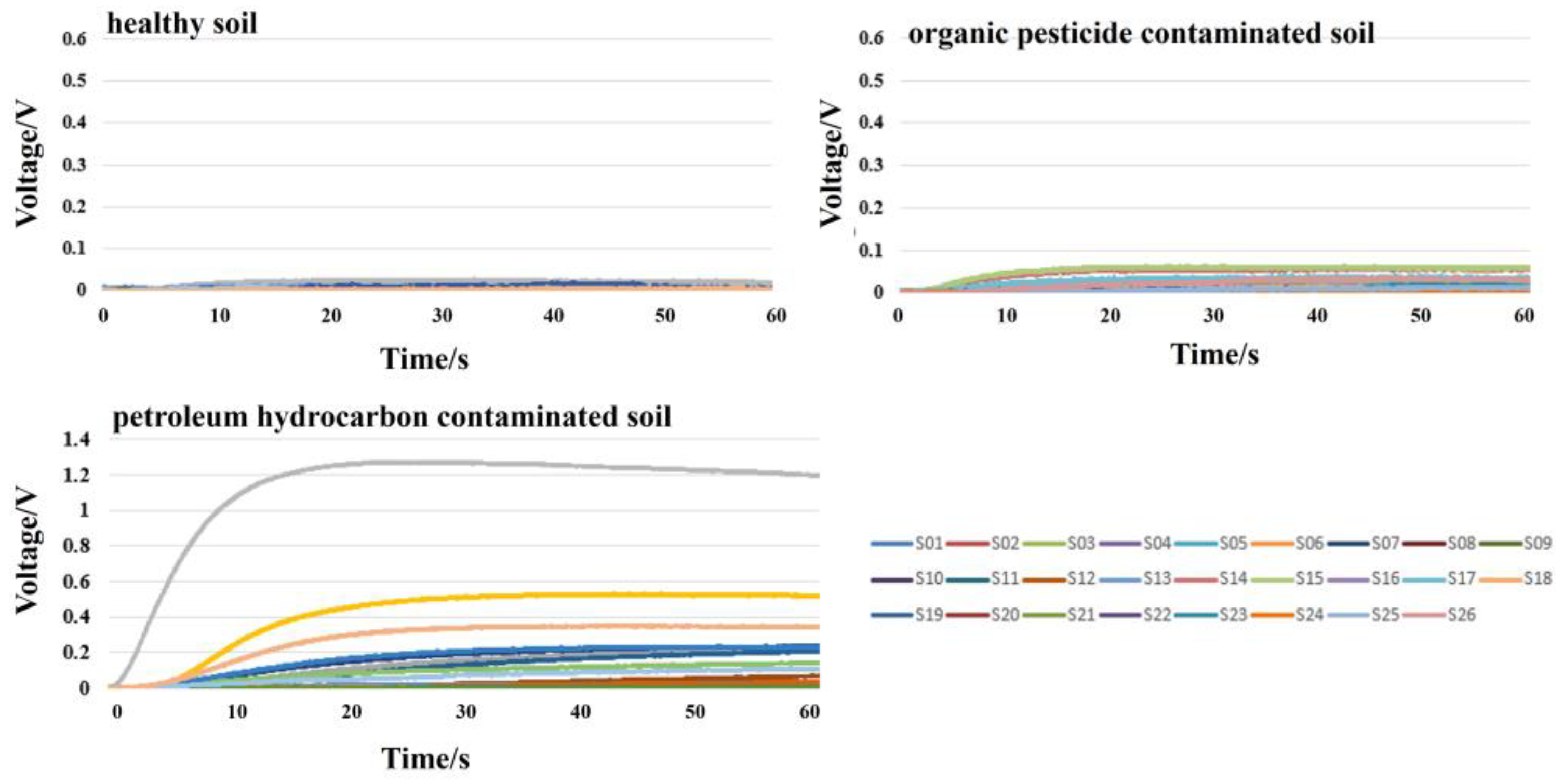
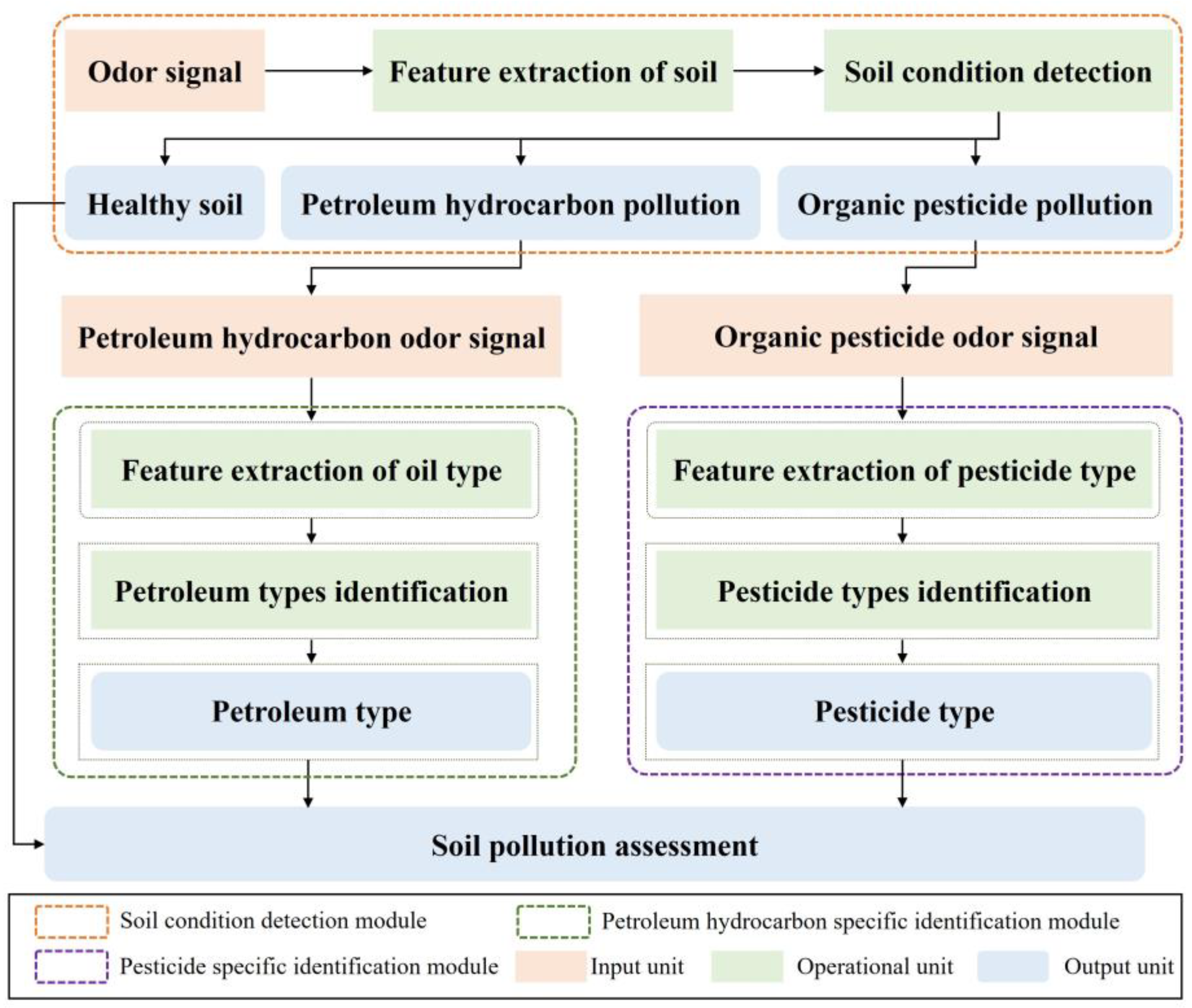
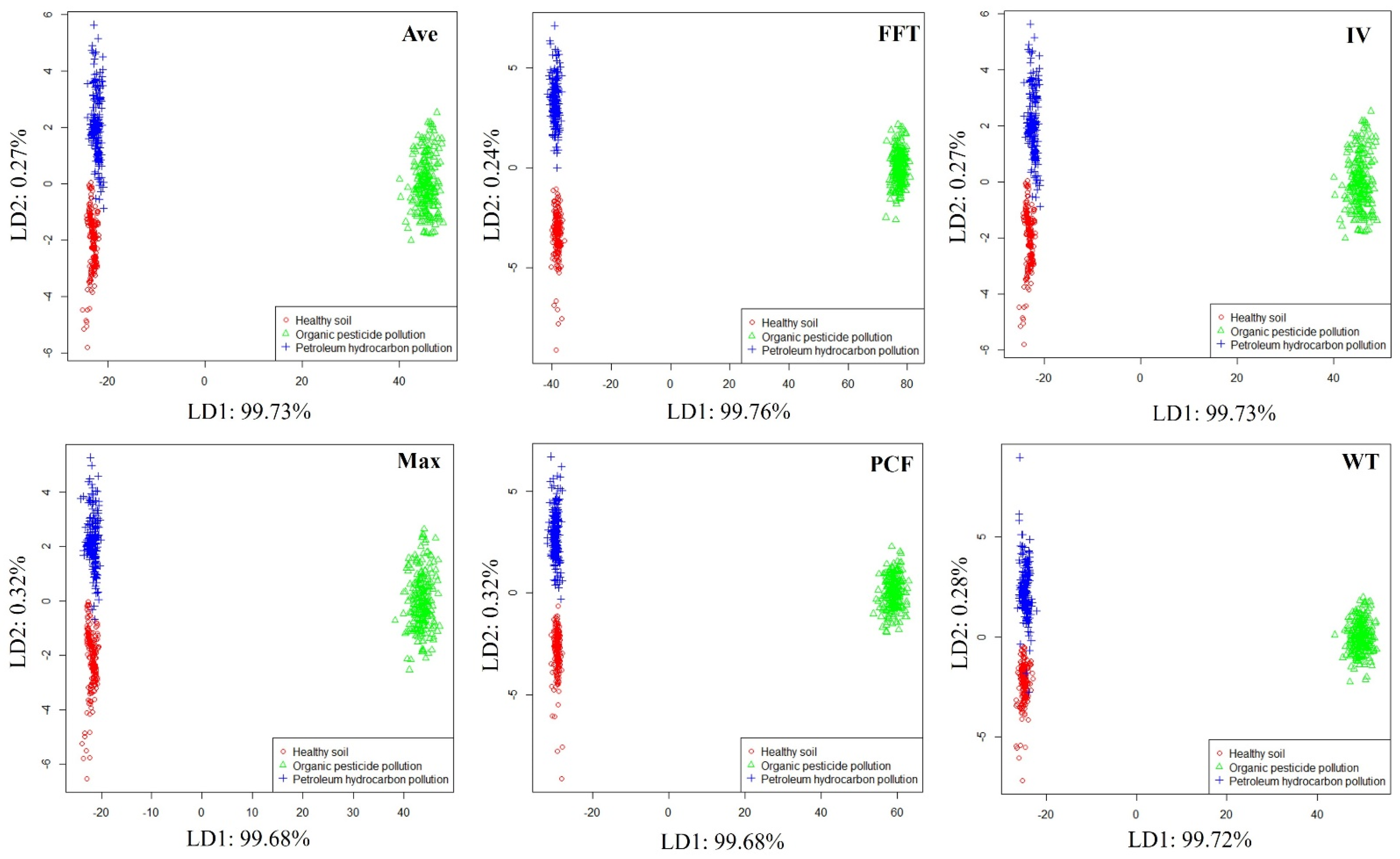
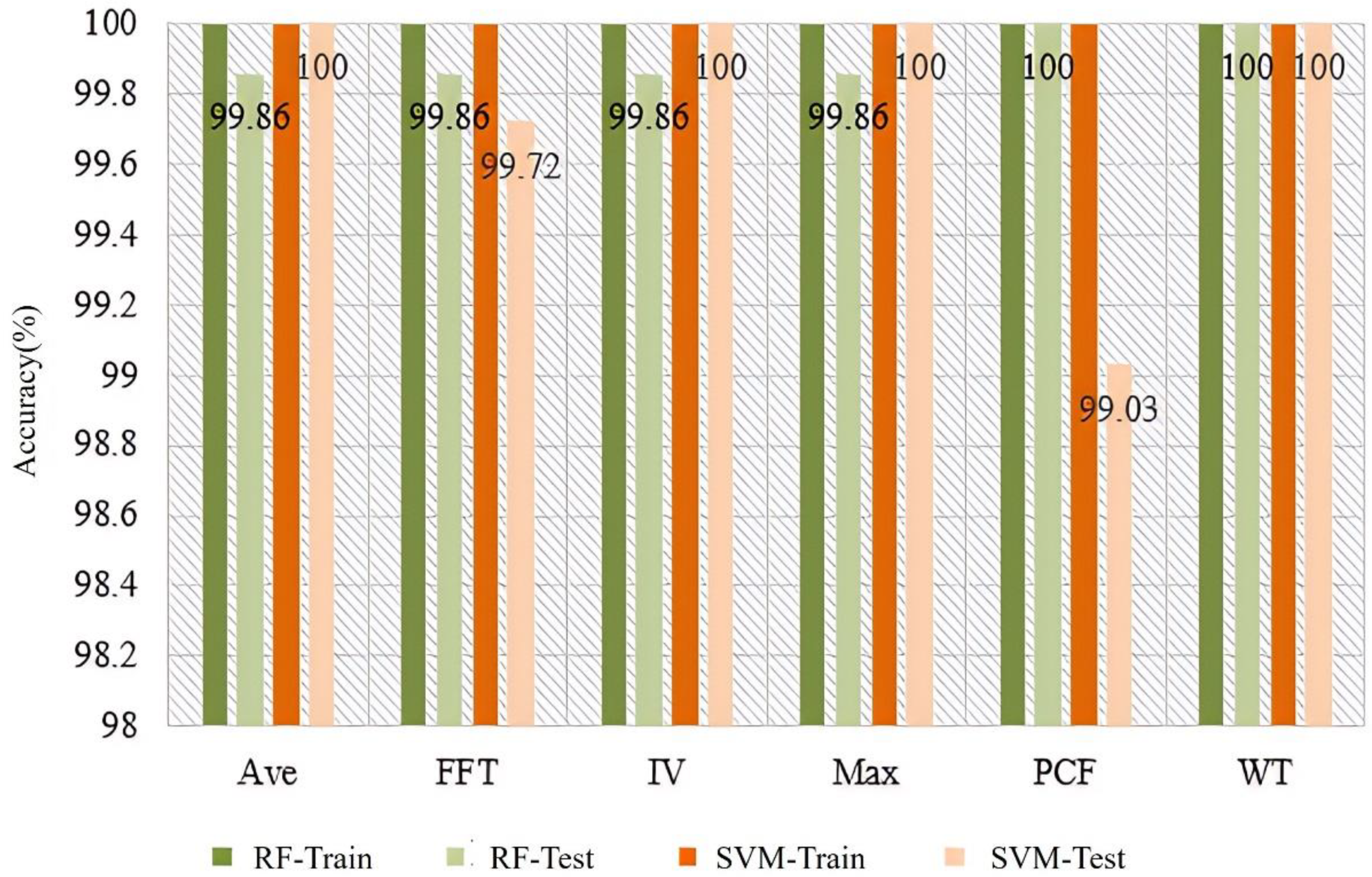
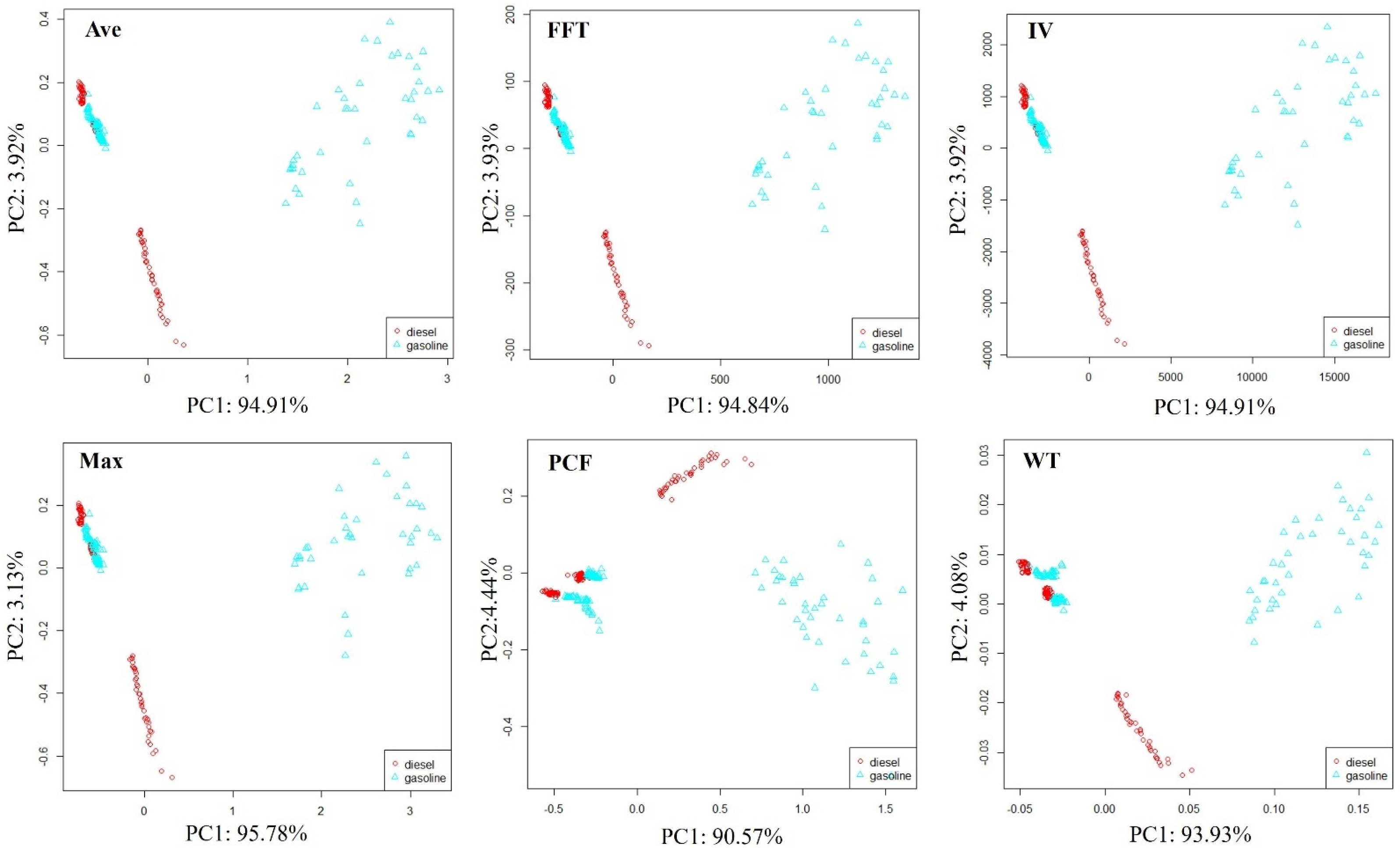

| Classifiers | Ave | FFT | IV | Max | PCF | WT | Average |
|---|---|---|---|---|---|---|---|
| SVM | 99.58% | 90.42% | 99.58% | 100.00% | 89.17% | 99.58% | 96.39% |
| RF | 99.17% | 99.17% | 98.33% | 99.58% | 98.75% | 97.92% | 98.82% |
| Average | 99.38% | 94.80% | 98.96% | 99.79% | 93.96% | 98.75% | 97.61% |
| Classifiers | Ave | FFT | IV | Max | PCF | WT | Average |
|---|---|---|---|---|---|---|---|
| SVM | 99.58% | 96.67% | 99.58% | 100.00% | 97.50% | 99.58% | 98.82% |
| RF | 99.17% | 95.83% | 99.17% | 98.33% | 97.92% | 99.17% | 98.27% |
| Average | 99.38% | 96.25% | 99.38% | 99.17% | 97.71% | 99.38% | 98.55% |
Disclaimer/Publisher’s Note: The statements, opinions and data contained in all publications are solely those of the individual author(s) and contributor(s) and not of MDPI and/or the editor(s). MDPI and/or the editor(s) disclaim responsibility for any injury to people or property resulting from any ideas, methods, instructions or products referred to in the content. |
© 2025 by the authors. Licensee MDPI, Basel, Switzerland. This article is an open access article distributed under the terms and conditions of the Creative Commons Attribution (CC BY) license (https://creativecommons.org/licenses/by/4.0/).
Share and Cite
Kong, C.; Sun, L.; Li, X.; Yan, Y.; Chang, Z.; Li, M.; Gou, F.; Rong, B. Rapid and Simultaneous Detection of Petroleum Hydrocarbons and Organic Pesticides in Soil Based on Electronic Nose. Sensors 2025, 25, 380. https://doi.org/10.3390/s25020380
Kong C, Sun L, Li X, Yan Y, Chang Z, Li M, Gou F, Rong B. Rapid and Simultaneous Detection of Petroleum Hydrocarbons and Organic Pesticides in Soil Based on Electronic Nose. Sensors. 2025; 25(2):380. https://doi.org/10.3390/s25020380
Chicago/Turabian StyleKong, Cheng, Lin Sun, Xiaodan Li, Yu Yan, Zhiyong Chang, Mo Li, Fuyan Gou, and Baojun Rong. 2025. "Rapid and Simultaneous Detection of Petroleum Hydrocarbons and Organic Pesticides in Soil Based on Electronic Nose" Sensors 25, no. 2: 380. https://doi.org/10.3390/s25020380
APA StyleKong, C., Sun, L., Li, X., Yan, Y., Chang, Z., Li, M., Gou, F., & Rong, B. (2025). Rapid and Simultaneous Detection of Petroleum Hydrocarbons and Organic Pesticides in Soil Based on Electronic Nose. Sensors, 25(2), 380. https://doi.org/10.3390/s25020380





